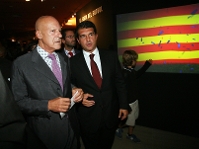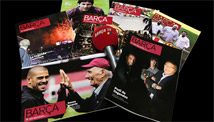FCBARCELONA.CAT
Main menu

Content menu
Football
24.09.2007 13:46
Foster: "We want to create the best stadium in the world"
Berta Brau
Norman Foster has accepted the challenge of remodelling the Camp Nou and adapting it to the needs of the 21st century while respecting the essence of the original design. The architect explains the project here with passion and absolute commitment.
In an exclusive interview with www.fcbarcelona.cat and Barça TV, Norman Foster talks about the elements and objectives that have inspired this project.
What’s your opinion of the existing Camp Nou?
"I believe that the stadium is a great building and it’s one of the inspirations for our design. But it’s the 50th anniversary and even though the needs have been covered between 1957 and now, a long time has passed by since then. The criteria change but we will respect that building. We won’t destroy anything. We’ll make it bigger. It’s a great building and it has an incredible atmosphere, so in a certain way we’ll try and add to and strengthen the best aspects. We’ll extend the asymmetrical bowl upwards and put on a roof to protect the public. But the roof will be movable and will allow the sun to shine down”.
Why did you present your project?
"How could any architect not want to compete? Barça is an institution, an incredible opportunity. So we were very enthusiastic and excited about doing this project and it’s fantastic that we were finally successful”.
How would you define your proposal for the new Camp Nou?
 "If I try and describe it with words it’s a bit complicated. The stadium is very
familiar to the fans so we’ll make it grow. We were inspired by it, with that fantastic
asymmetrical bowl, higher to the east. We’ll keep all of that, we’ll make it bigger,
put on a roof and improve the facilities. To reach the higher levels you can go up on escalators,
it’ll be well adapted for people with physical handicaps, we’ll increase the facilities
that are appropriate today and in the future. We want to create the best stadium in the world and
then we’ll cover it with a kind of mosaic, with an air of Gaudí. But the scales on that skin
are different, very colourful, with the colours of the Club and of Catalonia. That allows the
building to 'breathe'. And it’s an ecologically responsible building: collection of
rainwater, energy saving, the use of natural ventilation. It’ll be a good place to be”.
"If I try and describe it with words it’s a bit complicated. The stadium is very
familiar to the fans so we’ll make it grow. We were inspired by it, with that fantastic
asymmetrical bowl, higher to the east. We’ll keep all of that, we’ll make it bigger,
put on a roof and improve the facilities. To reach the higher levels you can go up on escalators,
it’ll be well adapted for people with physical handicaps, we’ll increase the facilities
that are appropriate today and in the future. We want to create the best stadium in the world and
then we’ll cover it with a kind of mosaic, with an air of Gaudí. But the scales on that skin
are different, very colourful, with the colours of the Club and of Catalonia. That allows the
building to 'breathe'. And it’s an ecologically responsible building: collection of
rainwater, energy saving, the use of natural ventilation. It’ll be a good place to be”.
What was your inspiration for the design?
"The inspirations were FC Barcelona, the stadium itself, its architecture, its history, its reputation, the city, Catalonia, the colours, the shapes...Some of these aspects can be defined, and others are more in the spirit of the place. Those are the inspirations”.
This new stadium will be integrated in the urban environment without fences to separate it from the street...
"It’s very soft in terms of the relationship with the surroundings. You have to remember that it’s an extraordinary challenge to transform, make these changes without closing off the stadium, keeping it open and allowing matches to carry on being played, without scaffolding, without cranes. It’s not aggressive, it respects the members and it’s also sensitive of the neighbours”.
Why do you speak about the challenge between the spiritual and the material?
How will you mange it so that the building works don’t affect the normal running of the stadium?
"We will avoid interrupting the normal running of the stadium thanks to an immense amount of research with the builders, of work with the specialists, with the engineers, to develop a concept that doesn’t need scaffolding, or cranes, so that the remodelling can be carried out during the season. Magically, the stadium will start being transformed. This building is almost never unoccupied, so every time there’s a match, the spectators will be able to see the progress of the project and finally, at the last moment, what is old and what is new will finally connect”.
The complete interview with Norman Foster will be broadcast on the programme Zona Mixta on Barça TV on Tuesday at 1.30 pm.
To view this content you need the latest version of the Flash Player
Common features with the Collserola Tower
The Camp Nou will not be Norman Foster’s first project in Barcelona. He also designed the
Collserola Tower, which stands on the hills overlooking the city. According to Foster, both
building have a number of points in common: “The juxtaposition between the stadium and the
Collserola Tower is interesting. It’s also interesting that, in different ways, both are very
delicate, very discrete in the use of cables. The Collserola Tower is very delicate on the skyline,
thanks to the fact that the cables that support it are almost invisible. We will use the same
principles, the same philosophy for the stadium. The cables will almost disappear.

